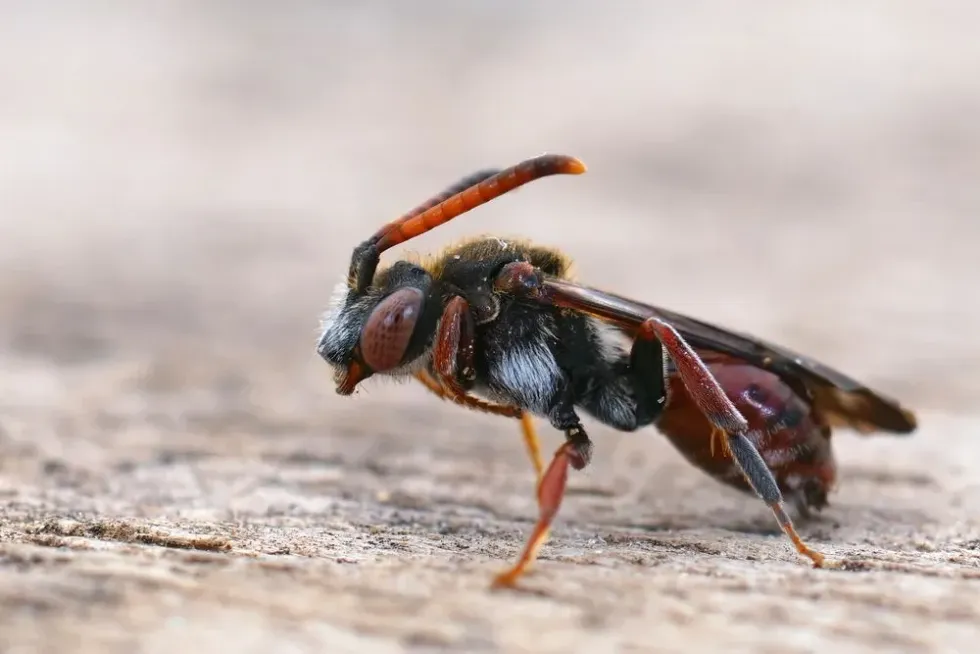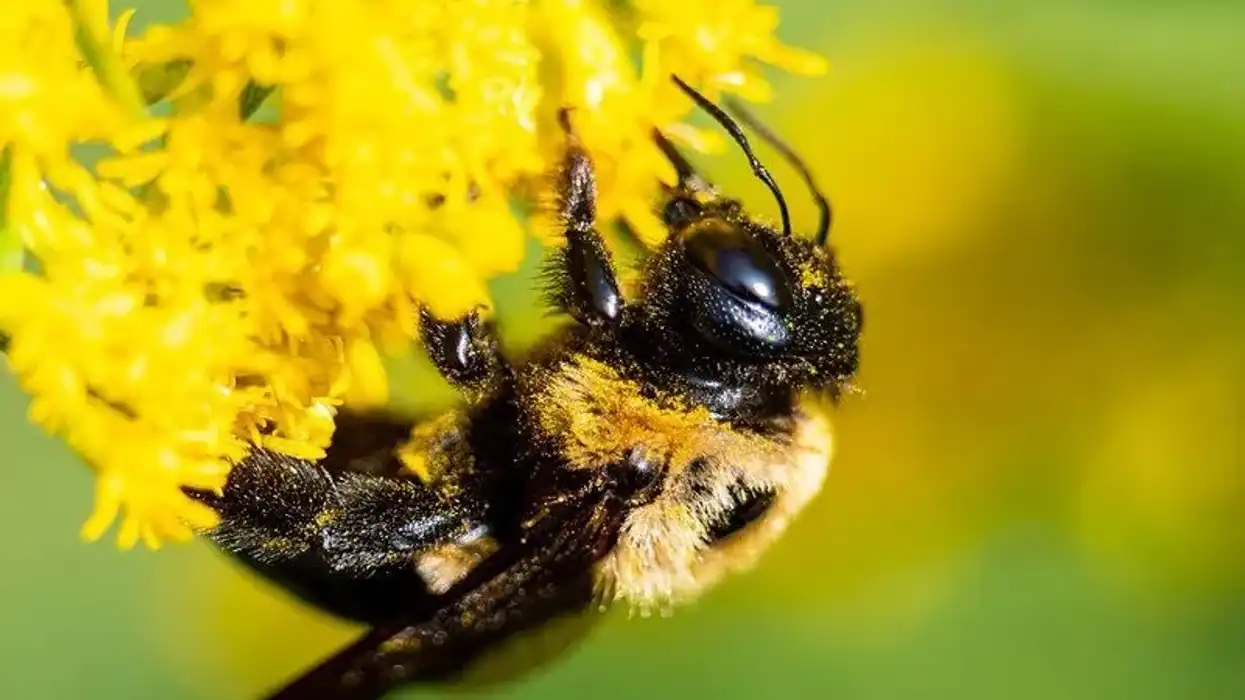Cuckoo bees are a parasitic insects that belong to the genus Nomada. There are more than 850 species with mild differences in appearance and behavior. But they mimic the lifestyle of their namesake, the cuckoo birds, by practicing kleptoparasitism or brood parasitism. In this setup, cuckoo birds lay their eggs in the nests of other birds.
With cuckoo bees, solitary females look for ground based nests developed by other “host” bees when they are ready to mate and lay their eggs. The male also secrets a hormone that is transferred to the female during mating, camouflaging her own unique smell.
This helps her to enter a nest without being detected. She parasitizes the nest to lay her eggs. When these hatch into larvae, they feed on the pollen balls foraged by the original owner of the nest.
Based on their evolutionary history, naturalists believe these bees have evolved 16 times when they practiced social parasitism, and evolved 31 times when they practiced solitary parasitism. This lifestyle of cuckoos, is both unique and precise. In fact, there is even an algorithm called the “search cuckoo” optimization algorithm to find solutions!
For more relatable content, check out these sweat bee facts and Africanized bees facts for kids.
Cuckoo Bee Interesting Facts
What type of animal is a cuckoo bee?
A cuckoo bee is an insect, like a honey bee or a wasp.
What class of animal does a cuckoo bee belong to?
It belongs to the (insecta) arthropod class under the Nomada classification.
How many cuckoo bee are there in the world?
The exact count is unknown, though experts estimate there are thousands of these bees spread all over the world. Also, there are more than 850 Nomada species of cuckoo bees.
Where does a cuckoo bee live?
This Nomada bee can be seen in a tropical rainforest, as it feeds on the nectar of flowers when it is not looking for a host cell. Females look for nests created on the ground by other host bees, so they are also found in the open woods or on a farm.
Cuckoo bees are found in North America, South America, Europe, Asia, and some parts of Africa.
What is a cuckoo bee's habitat?
These parasites aren’t too picky about their habitat, especially in North America, as they only look for nests on the ground that have pollen foraged by other bees. They are mostly found in open habitats. They may be also found on land that is rich in vegetation, provided it is surrounded by flowers filled with nectar.
Who do cuckoo bee live with?
They are solitary creatures, and mix with the other gender only when it is time to mate. There are 850+ species of Nomada, and majority of them are brood or klepto parasites - much like their namesake, the cuckoo bird.
Here, the female looks for nests on the ground created by other solitary bees when she is ready to lay eggs. The male helps to mask the female’s scent during mating, so she can easily enter a host’s nest without (olfactory) detection.
She parasitizes the nest and lays her eggs among the host cells. After this, she goes back to her solitary life.
In some cases, this Nomada bee may also practice brood parasitism, where she sneaks in her egg into a queen bee's colony. In extreme cases, the female Nomada may end up killing the queen bee, and parasitize the entire colony and workers of the former queen bee.
This type of behavior – where bees live together in a colony and collectively take care of juveniles, is called “eusociality”.
So, in essence, cuckoo bees are natural, solitary creatures that practice klepto or brood parasitism. In rare cases, a female cuckoo may become a eusocial queen herself, when she kills a queen bee and parasitizes her entire colony and workers.
How long does a cuckoo bee live?
Depending on the species, the cuckoo bee can live anywhere between 28 days to 2-3 years. A solitary cuckoo bee tends to have a shorter lifespan. On the other hand, a eusocial queen bee has a longer life span (average of three years).
How do they reproduce?
Male cuckoo bees are black in color and often seen on flowers filled with nectar. They have ample scopa on their bodies to attract and carry pollen. Female cuckoos lack “scopial hair” on their body which is responsible for attracting and collecting pollen. Instead, they look for a nest built by another bee which has foraged pollen.
During the mating season (typically during the wet season when the flowers are in full bloom), male bees use their olfactory senses and hormone secretion to attract females. When a pair mate, the male connects with the female’s antennae to transfer the secretion to her body.
This makes her unattractive to other males for some time, and also helps to camouflage her own unique smell. This also helps her parasitize a built nest without detection when the host is away, so can lay 1-2 eggs with the nest’s cells.
In most species, the female moves on after laying her egg. In some cases, she may even kill the host eggs and larvae, so all food foraged in the nest is available to her young ones. Eventually, the cuckoo bee egg hatches into a larva and feeds on the pollen balls foraged in the nest.
This type of nesting behavior is common across klepto and brood parasites, just like the cuckoo bird.
What is their conservation status?
There are over 850 species of cuckoo bees, classified under the genus Nomada. A majority of these species have a conservation status of “Not Extinct” as they are unlisted in IUCN’s red list.
But bees in general are facing a loss of habitat in the past few years, primarily due to the increased usage of pesticides in agriculture. Naturalists hence believe that several cuckoo bee species may soon become endangered in the near future.
Cuckoo Bee Fun Facts
What do cuckoo bee look like?

Cuckoo bees resemble wasps in appearance, and are black in color with red and yellow accents. There are also some species of neon (blue) cuckoo bees in Australia. Regardless, the male cuckoo bee can be identified by the presence of scopa – fine hair that attracts and carries pollen. Some species are also strong pollinators.
In contrast, female cuckoo bees lack scopa, as they depend on other hosts that have already foraged pollen in their ground based nest. Female cuckoos also have light patches of hair on their abdominal region, and two mandibles – sharp teeth like parts useful in killing the host bee and host larvae.
How cute are they?
These parasitic bees are not all that cute to look at! In fact, they look similar to many poisonous wasps. And despite their small size (less than a centimeter), these bees also have a mighty sting that can hurt for hours!
How do they communicate?
As is the case with most insects, cuckoo bees use their olfactory senses to communicate. During the mating season, the males secrete a hormone to attract females. They even transfer this secretion to the female’s antennae during mating.
In turn, the female becomes unattractive to other males for a while. The male’s secretion also camouflages the female cuckoo bee’s personal smell. With this, she is able to easily move into a host nest, undetected.
How big is a cuckoo bee?
Cuckoo bees vary in size, depending on the species. The smallest of this species is less than 5 mm (0.5 cm) in length. This is one third the size of the popular honey bee.
How fast can a cuckoo bee fly?
Bees can fly between 12–16 mph (20–25 kph). Females cuckoos may rarely achieve this speed, as they do not seek colon. Instead, they stealthily look for a host that has already foraged pollen and formed nests on the ground.
How much does a cuckoo bee weigh?
Parasitic cuckoo bees are tiny insects, weighing less than an ounce (less than 10 g).
What are the male and female names of the species?
As is common in all bee species, male cuckoo bees are called drones. A female cuckoo bee may be a solitary parasitic bee, or go on to become a eusocial queen bee.
What would you call a baby cuckoo bee?
This depends on the development stage. The young ones of a cuckoo bee go through four unique development stages, as follows:
Eggs, typically laid by the female cuckoo bee on the ground, within a host bee’s nest cell.
Larva, or a hatched egg.
Pupa, where the insect has eaten enough for development and is awaiting the final phase.
Fully formed adult bee.
What do they eat?
Cuckoo bees feed on the nectar available on flowers. During the larva stage, the young ones of a cuckoo bee feed on the pollen balls collected in a host’s nest.
Many species of cuckoo bees are vulnerable to predators, including many species of bears.
Are they poisonous?
Cuckoo bees are not necessarily poisonous to humans. But some species do have a painful sting that lasts for hours. Also, they can be “poisonous” to hosts, as the female cuckoo bee can kill host larvae (and even the host) with her mandibles.
Would they make a good pet?
Cuckoo bees are parasitic in nature, looking for host bees to parasitize. Some species can also mimic the sting of a wasp! So they do not make good pets.
Did you know...
The female cuckoo bee is quite a “sleeper”, with the ability to sleep on leaves and flowers, just by resting on them using her tiny two mandibles (teeth like mouth parts)!
Are cuckoo bee parasitic?
Yes, cuckoo bees are indeed parasitic in nature.
There are more than 850 species of Nomada who practice varied forms of parasitism.
This includes Klepto parasitism, where they “steal” another host bee’s nest and food; Social parasitism, where a female cuckoo bee parasitizes a queen bee’s colony and workers; Brood parasitism, where the female cuckoo bee parasitizes a host’s nest, and kills the host larvae so her own eggs/ larvae have food to eat.
In extreme cases, she may also have to kill the host bee itself before parasitizing the nest.
Can a cuckoo wasp sting?
Yes, a female cuckoo wasp can sting using its 2 mandibles – sharp, teeth like objects that line either side of its mouth. Some species have a painful sting that may hurt for hours. However, they are generally not considered as poisonous to humans.
Here at Kidadl, we have carefully created lots of interesting family-friendly animal facts for everyone to discover! For more relatable content, check out these asian lady beetle facts and hister beetle facts pages.
You can even occupy yourself at home by drawing one on our [rhino beetle] coloring pages. You can even occupy yourself at home by coloring in one of our Cuckoo Bee coloring pages.









